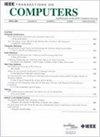A Context-Awareness and Hardware-Friendly Sparse Matrix Multiplication Kernel for CNN Inference Acceleration
IF 3.6
2区 计算机科学
Q2 COMPUTER SCIENCE, HARDWARE & ARCHITECTURE
引用次数: 0
Abstract
Sparsification technology is crucial for deploying convolutional neural networks in resource-constrained environments. However, the efficiency of sparse models is hampered by irregular memory access patterns in sparse matrix multiplication kernels. Hardware-level support for 2:4 granularity in sparse tensor cores presents an opportunity for designing efficient sparse matrix multiplication kernels. Existing approaches often involve adjusting sparse structures or secondary sparsification, introducing additional computational errors. To tackle this challenge, we introduce a flexible 2:4 structured adaptive sparse matrix multiplication (FS-AMM) method, a hardware-friendly sparse matrix multiplication kernel that leverages model context to accelerate convolutional neural networks. First, we propose a model context-aware matrix pre-processing method that employs heuristic algorithms to estimate a loss of accuracy due to weight sparsity at each layer. Second, we design a hardware-friendly sparse storage format that combines 2:4 sparse and dense storage formats, enabling more versatile sparsity ratio selection. Third, we implement efficient matrix multiplication kernels to optimize GPU utilization. Finally, experimental results on A100 GPUs show that our method effectively utilizes the sparse tensor kernel and obtains an average 3.09 times speedup ratio compared to other sparse methods while maintaining a high accuracy.求助全文
约1分钟内获得全文
求助全文
来源期刊

IEEE Transactions on Computers
工程技术-工程:电子与电气
CiteScore
6.60
自引率
5.40%
发文量
199
审稿时长
6.0 months
期刊介绍:
The IEEE Transactions on Computers is a monthly publication with a wide distribution to researchers, developers, technical managers, and educators in the computer field. It publishes papers on research in areas of current interest to the readers. These areas include, but are not limited to, the following: a) computer organizations and architectures; b) operating systems, software systems, and communication protocols; c) real-time systems and embedded systems; d) digital devices, computer components, and interconnection networks; e) specification, design, prototyping, and testing methods and tools; f) performance, fault tolerance, reliability, security, and testability; g) case studies and experimental and theoretical evaluations; and h) new and important applications and trends.
 求助内容:
求助内容: 应助结果提醒方式:
应助结果提醒方式:


